Your patio is an extension of your home, a place where you can relax and entertain guests. To create an inviting and visually appealing space, it’s essential to pay attention to every detail, including the edging of your patio pavers. In this article, we will explore a variety of patio paver edging ideas that will enhance your outdoor living experience.
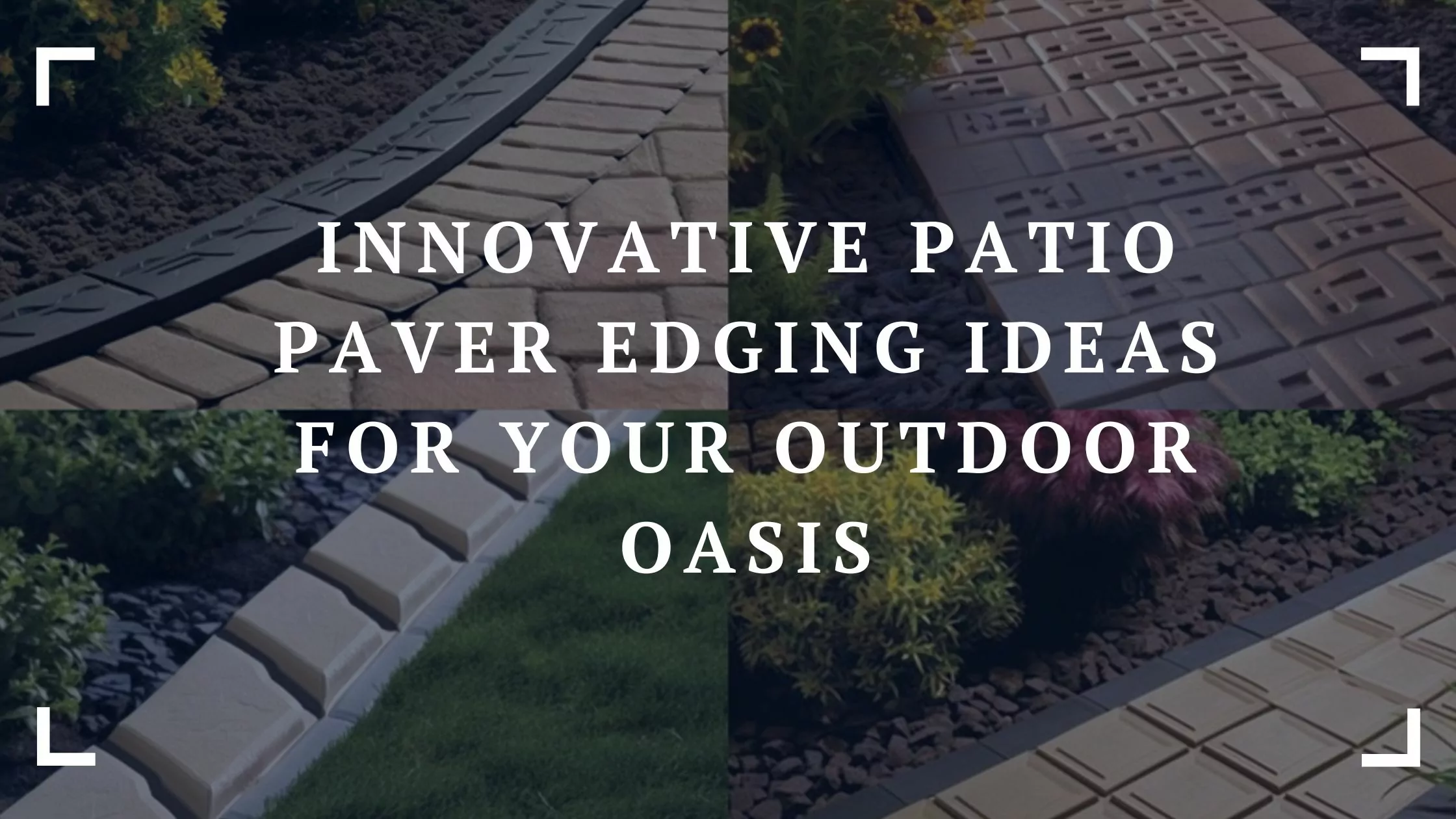
The Importance of Patio Paver Edging
Patio paver edging is a vital component of any well-designed outdoor space. By incorporating appropriate edging materials and techniques, you can enhance the functionality, aesthetics, and safety of your patio. Let’s take a closer look at these three essential aspects of patio paver edging:
Structural Support
One of the primary purposes of patio paver edging is to provide structural support to the entire paved area. By containing the pavers and preventing them from shifting or separating over time, edging ensures the stability and longevity of your patio. This is particularly important in regions with fluctuating temperatures or frequent precipitation, as these conditions can cause the ground to expand and contract, leading to paver movement. To add to the structural integrity of patio pavers as well as retaining walls, you should look into 200pfc steel that helps maintain the structural support of your patio as well as any land that’s being held together by retaining walls.
Aesthetic Appeal
In addition to its structural benefits, patio paver edging contributes significantly to the overall appearance of your outdoor space. With a wide range of materials, colors, and styles available, you can select the ideal edging option to complement your patio’s design and create a cohesive, visually appealing look. By paying attention to the details and choosing an edging material that aligns with your aesthetic preferences, you can transform your patio into an inviting and attractive area for relaxation and entertainment.
Safety
Lastly, patio paver edging plays a critical role in ensuring the safety of your outdoor space. By creating a well-defined border around the paved area, edging helps reduce the risk of tripping or stumbling over uneven edges. This is particularly important in spaces that see frequent foot traffic, such as walkways, pool decks, or outdoor dining areas.
Brick Patio Paver Edging
Brick edging is a timeless and popular option for patio borders, offering a classic and versatile choice that complements various outdoor design styles. With an array of colors, textures, and patterns available, brick edging can be tailored to suit your unique aesthetic preferences and enhance your patio’s visual appeal.
Popular Brick Edging Patterns
There are several brick edging patterns you can use to create a visually striking border for your patio:
Soldier Course
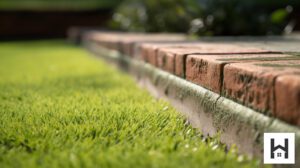
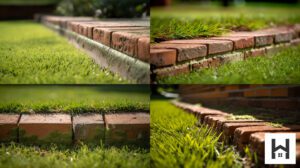
The soldier course involves placing bricks vertically along the edge of your patio pavers, creating a clean and uniform appearance. This pattern adds a sense of height to your patio design and works well with both traditional and contemporary styles.
Sailor Course
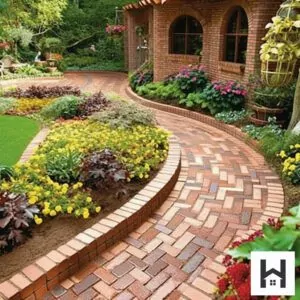
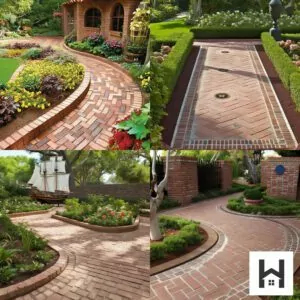
In the sailor course pattern, bricks are laid horizontally along the paver edge, resulting in a wider border. This style provides additional visual interest and structure, making it a suitable option for larger patios or those with bold design elements.
Basketweave
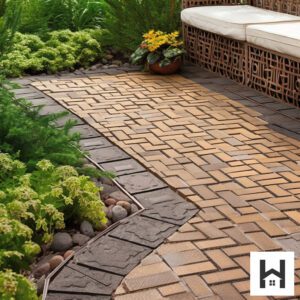
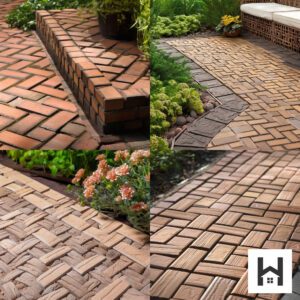
The basketweave pattern alternates horizontal and vertical bricks, creating a woven appearance that adds texture and depth to your patio edging. This intricate design is well-suited for traditional or rustic patio styles.
Advantages of Brick Edging
There are several benefits to choosing brick as your patio paver edging material:
- Durability: Brick is a strong and long-lasting material that can withstand various weather conditions, making it an excellent choice for outdoor applications.
- Low maintenance: Brick edging requires minimal upkeep, as it is resistant to moisture and does not fade or discolor over time.
- Versatility: With numerous colors, textures, and patterns to choose from, you can easily find a brick style that suits your patio design.
- Eco-friendly: Many bricks are made from natural clay or recycled materials, making them an environmentally friendly option.
Disadvantages of Brick Edging
While brick edging is a popular and versatile option for patio borders, it’s important to consider some potential drawbacks before deciding on this material for your outdoor space. Understanding these disadvantages can help you make an informed decision about the best edging material for your patio.
- Limited Design Options. Brick edging offers fewer design options compared to other materials like natural stone or concrete. While there are various colors and textures available, brick shapes are generally limited to rectangular or square forms. This constraint may not appeal to those seeking more unique or unconventional edging designs.
- Susceptibility to Weathering. Brick is porous and can be susceptible to weathering and damage over time, particularly in areas with freeze-thaw cycles. Water can penetrate the brick’s pores and freeze, causing the brick to crack or crumble. To prevent this, it’s essential to use bricks specifically designed for outdoor use and apply a sealant to protect them from moisture damage.
- Maintenance. While brick edging is generally low-maintenance, it may require occasional upkeep to maintain its appearance and structural integrity. Mortar joints between bricks can deteriorate over time and may need to be repointed or replaced. Additionally, bricks can become discolored or develop efflorescence (white mineral deposits) due to moisture exposure. Regular cleaning and sealing can help minimize these issues.
- Installation. Installing brick edging can be labor-intensive, particularly for intricate patterns or curves. Bricks need to be cut and shaped to fit the desired design, which can be time-consuming and require specialized tools. Additionally, the installation process may involve excavating and preparing the ground, leveling the bricks, and using mortar or other adhesives to secure them in place.
More resources:
- Brick Industry Association: Learn more about brick styles and applications.
Natural Stone Patio Paver Edging
Natural stone is a popular and sophisticated choice for patio edging, providing an organic and visually striking option for your outdoor space. With a variety of types, colors, and textures available, natural stone can be customized to suit your patio’s design and enhance its overall aesthetic appeal.
Popular Natural Stone Edging Styles
There are several natural stone edging styles you can use to create a visually appealing border for your patio:
Stacked Stone
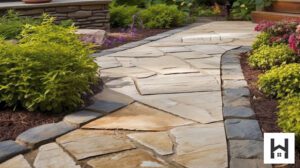
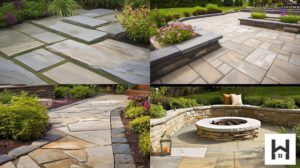
Stacked stone edging involves layering stones on top of one another to create a textured, three-dimensional effect. This style adds depth and dimension to your patio design and works well with both traditional and contemporary styles.
Mortared Stone
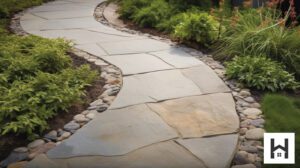
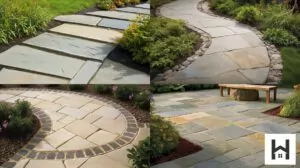
For a more polished and refined look, consider mortared stone edging. This technique involves setting stones in mortar for a secure and seamless finish. Mortared stone edging is suitable for formal patio designs and can be used to create straight or curved borders.
Dry-laid Stone
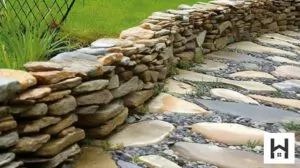
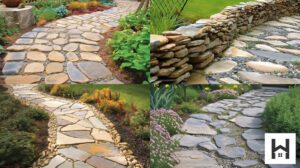
Dry-laid stone edging does not use mortar or adhesive to hold the stones in place. Instead, stones are meticulously placed and fitted together like a puzzle, allowing for a more natural and organic appearance. This style works well in rustic or cottage-style patios.
Advantages of Natural Stone Edging
There are several benefits to choosing natural stone as your patio paver edging material:
- Durability: Natural stone is strong and long-lasting, able to withstand various weather conditions and resist wear and tear over time.
- Uniqueness: Each piece of natural stone is distinct, featuring its own colors, patterns, and textures. This results in a one-of-a-kind patio border that adds character and charm to your outdoor space.
- Versatility: Natural stone is available in many types, including cobblestone, flagstone, limestone, and slate, allowing you to find the perfect match for your patio design.
- Low maintenance: Natural stone requires minimal upkeep and can be easily cleaned with water and a mild detergent.
Disadvantages of Natural Stone Edging
While natural stone edging offers numerous benefits and aesthetic appeal, it’s essential to consider some potential drawbacks before deciding on this option for your patio. Understanding these disadvantages can help you make an informed decision about the best material for your outdoor space.
- Cost. One of the primary disadvantages of natural stone edging is the cost. Natural stone materials tend to be more expensive than other edging options, such as concrete, brick, or wood. The price can vary depending on the type of stone, its quality, and where it is sourced. Some suppliers allow you to purchase stone in bulk, greatly reducing your overall expenses. Bulk stone purchases can lead to lower per-unit prices, making natural stone edging a more budget-friendly option. Additionally, labor costs for installing natural stone edging can be higher, as it typically requires skilled craftsmanship to ensure proper fitting and placement.
- Installation. Natural stone edging installation can be more labor-intensive and time-consuming than other materials. The process often involves cutting, shaping, and fitting individual stones, which can be challenging and require specialized tools and skills. This can lead to increased labor costs and longer installation times compared to other edging options.
- Maintenance. While natural stone is generally low-maintenance, some types may require additional care to maintain their appearance and durability. For example, certain stones may be susceptible to staining or weathering and may need to be sealed or treated periodically to preserve their natural beauty. Furthermore, if mortar is used in the installation, it may deteriorate over time and require occasional repair or replacement.
- Weight. Natural stone edging can be significantly heavier than other materials, which can pose challenges during installation and potentially impact the underlying soil or structure of your patio. Proper preparation and reinforcement may be necessary to accommodate the weight of the stone and ensure the long-term stability of your patio edging.
More resources:
- Natural Stone Institute: Discover the benefits and applications of natural stone.
Metal Patio Paver Edging
Metal edging is a contemporary and stylish choice for patio borders, offering a sleek and durable option that complements various outdoor design styles. With a range of materials, finishes, and profiles available, metal edging can be tailored to suit your patio’s design and enhance its overall aesthetic appeal.
Popular Metal Edging Materials
There are several metal edging materials you can use to create a visually appealing border for your patio:
Aluminum
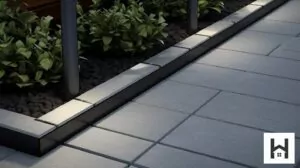
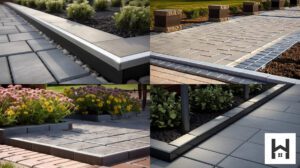
Aluminum is a lightweight and corrosion-resistant metal that is easy to work with and install. It is available in various colors and finishes, making it a versatile choice for your patio edging. Additionally, aluminum edging is an environmentally friendly option, as it is recyclable and often made from recycled materials.
Steel
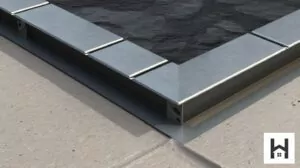
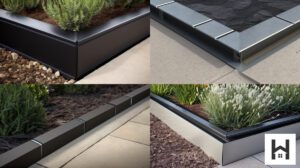
Steel edging is a sturdy and long-lasting option that offers a sleek, modern aesthetic. Available in various finishes, including galvanized, powder-coated, or stainless steel, this material can provide a clean and contemporary look for your patio border. Keep in mind that steel edging can be heavier than other materials, which may affect installation ease and cost.
Corten Steel
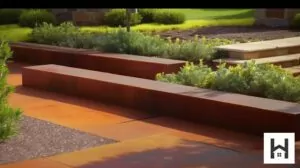
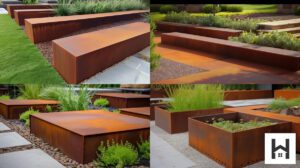
Corten steel, also known as weathering steel, develops a protective rust-like patina over time, giving it a unique and organic appearance. This material is well-suited for rustic or industrial-inspired patio designs and offers excellent durability and corrosion resistance.
In conclusion, metal edging is a sleek and modern choice for patio paver borders, offering durability, low maintenance, and a wide range of design possibilities. By selecting a metal material and style that complements your patio design, you can create a cohesive and visually appealing outdoor space that is built to last.
Advantages of Metal Edging
There are several benefits to choosing metal as your patio paver edging material:
- Durability: Metal edging is strong and long-lasting, able to withstand various weather conditions and resist wear and tear over time.
- Low maintenance: Metal edging requires minimal upkeep, as it is resistant to moisture, rust, and corrosion when properly treated or coated.
- Easy installation: Metal edging is typically lightweight and easy to install, making it a more accessible option for DIY enthusiasts or those seeking a quick and efficient installation process.
- Versatility: With numerous materials, finishes, and profiles to choose from, you can easily find a metal edging style that suits your patio design and personal preferences.
Disadvantages of Metal Edging
While metal edging offers several benefits and a modern aesthetic, it’s important to consider some potential drawbacks before deciding on this material for your patio borders. Understanding these disadvantages can help you make an informed decision about the best edging material for your outdoor space.
- Cost. Metal edging can be more expensive than other materials, such as plastic or wood, depending on the type of metal and finish selected. The initial investment might be higher, but the long-term durability and low maintenance requirements of metal edging can offset the initial cost.
- Potential for Corrosion. Although metal edging materials like aluminum and stainless steel are resistant to corrosion, other metals may be susceptible to rust or corrosion over time, particularly in areas with high humidity or frequent precipitation. Choosing a material with proper coating or treatment can help mitigate this issue.
- Safety Concerns. Some metal edging materials may have sharp edges, posing a safety risk if not installed and finished correctly. It is essential to ensure that any exposed edges are properly smoothed or covered to prevent injuries, especially in areas with high foot traffic or where children and pets may be present.
- Aesthetic Limitations. While metal edging offers a sleek and modern aesthetic, it may not be the ideal choice for all patio designs. For instance, those seeking a more traditional or natural look might prefer options like brick or natural stone edging. Metal edging may be better suited for contemporary or minimalist patio designs.
Concrete Patio Paver Edging
Concrete edging is a practical and cost-effective choice for patio borders, offering a durable and highly customizable option that complements various outdoor design styles. With a range of colors, textures, and shapes available, concrete edging can be tailored to suit your patio’s design and enhance its overall aesthetic appeal.
Popular Concrete Edging Styles
There are several concrete edging styles you can use to create a visually appealing border for your patio:
Poured Concrete
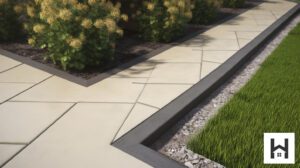
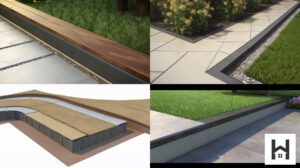
Poured concrete edging involves pouring concrete into a form or mold to create a continuous, seamless border around your patio. This style provides a clean and modern appearance and can be customized with various colors and textures to match your patio design.
Precast Concrete
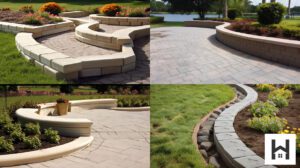
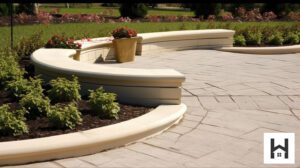
Precast concrete edging consists of individual concrete pieces or blocks that are manufactured off-site and installed along your patio’s perimeter. This style offers more flexibility in terms of design, as you can choose from a variety of shapes, sizes, and finishes to create a unique and visually interesting border.
Stamped or Textured Concrete
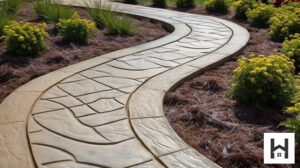
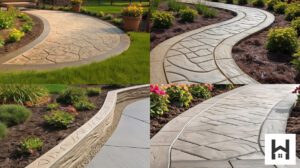
Stamped or textured concrete edging involves imprinting patterns or textures onto the surface of the concrete to create a more decorative and appealing appearance. This style can mimic the look of natural stone, brick, or wood, offering a wide range of design possibilities to suit your patio’s aesthetic.
Advantages of Concrete Edging
There are several benefits to choosing concrete as your patio paver edging material:
- Durability: Concrete is strong and long-lasting, able to withstand various weather conditions and resist wear and tear over time.
- Cost-effective: Concrete edging is generally more affordable than other materials like natural stone or metal, making it a budget-friendly option for your patio project.
- Customizability: With numerous colors, textures, and forms to choose from, you can easily create a unique and personalized concrete edging style that suits your patio design.
- Low maintenance: Concrete edging requires minimal upkeep, as it is resistant to moisture and does not fade or discolor over time.
Disadvantages of Concrete Edging
While concrete edging offers several benefits, such as durability, customizability, and cost-effectiveness, it’s important to consider some potential drawbacks before deciding on this material for your patio borders. Understanding these disadvantages can help you make an informed decision about the best edging material for your outdoor space.
- Cracking. One of the primary disadvantages of concrete edging is its susceptibility to cracking over time. Concrete can crack due to factors such as freeze-thaw cycles, ground movement, and tree root growth. While cracks can be repaired, they may detract from the overall appearance of your patio edging.
- Installation. Concrete edging installation can be more labor-intensive than other materials, particularly when dealing with poured concrete. Proper preparation, such as excavation, ground leveling, and formwork, is necessary to ensure the concrete sets correctly and maintains its desired shape. Additionally, the curing process can take several days to weeks, which may prolong the completion of your patio project.
- Aesthetic Limitations. While concrete edging is highly customizable, it may not provide the same natural or authentic appearance as materials like brick or natural stone. Some homeowners may prefer the look and texture of these alternative materials over concrete, even when considering stamped or textured options.
- Potential for Discoloration. Although concrete is generally resistant to fading, it can be susceptible to discoloration from factors like weathering, staining, or efflorescence (white mineral deposits). Proper sealing and maintenance can help minimize these issues, but it’s essential to be aware of the potential for discoloration over time.
Wood Patio Paver Edging
Wood edging is a versatile and eco-friendly choice for patio borders, offering a warm and natural aesthetic that complements various outdoor design styles. With a range of wood species, finishes, and styles available, wood edging can be tailored to suit your patio’s design and enhance its overall visual appeal.
Popular Wood Edging Options
There are several wood edging options you can use to create a visually appealing border for your patio:
Landscape Timbers
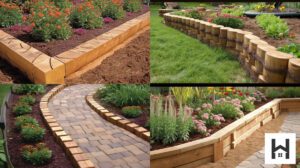
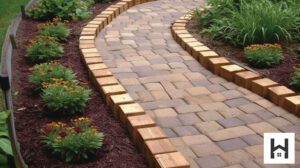
Landscape timbers are large, flat wooden boards typically used for creating raised garden beds or retaining walls. They can also be used as edging for patios, providing a sturdy and durable border that can be stained or painted to match your outdoor design.
Wooden Logs
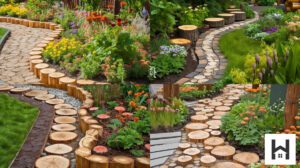
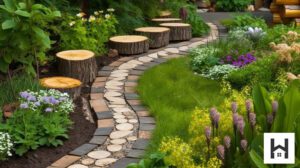
Wooden logs or rounds can be used as edging for a more rustic and natural appearance. By placing logs of various diameters and lengths along the border of your patio, you can create an organic and visually interesting edge that complements your outdoor space.
Wooden Planks
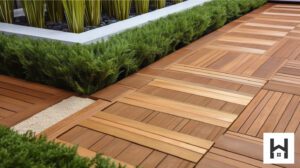
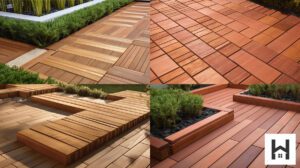
Wooden planks, such as decking boards or reclaimed wood, can be used as patio edging for a clean and contemporary look. These planks can be arranged horizontally or vertically, depending on your desired aesthetic, and can be stained or painted to match your patio’s color scheme.
Custom Wood Edging
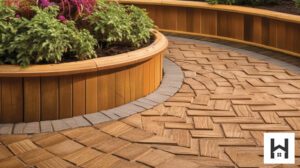
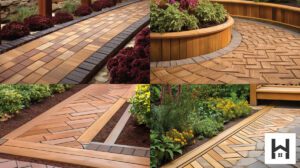
For a more unique and personalized look, consider custom wood edging. Work with a skilled carpenter or woodworker to create a one-of-a-kind border that reflects your individual style.
Advantages of Wood Edging
There are several benefits to choosing wood as your patio paver edging material:
- Natural Aesthetic: Wood edging provides a warm and inviting appearance that blends seamlessly with outdoor environments, making it an ideal choice for those seeking a natural and organic look.
- Eco-Friendly: Wood is a renewable and biodegradable material, making it an environmentally friendly option for your patio edging.
- Ease of Installation: Wood edging is relatively easy to install compared to other materials, such as concrete or natural stone, making it a more accessible option for DIY enthusiasts or those seeking a quick and efficient installation process.
- Customizability: With various wood species, finishes, and styles to choose from, you can easily create a unique and personalized wood edging style that suits your patio design.
Disadvantages of Wood Edging
While wood edging offers several benefits, such as a warm and natural aesthetic, eco-friendliness, and ease of installation, it’s important to consider some potential drawbacks before deciding on this material for your patio borders. Understanding these disadvantages can help you make an informed decision about the best edging material for your outdoor space.
- Durability Concerns. One of the primary disadvantages of wood edging is its susceptibility to rot, decay, and insect damage. Exposure to moisture and varying weather conditions can cause wood to degrade over time, affecting its longevity compared to more durable materials like concrete or metal. Choosing a rot-resistant wood species, such as cedar or redwood, and applying appropriate sealants can help mitigate these issues.
- Maintenance Requirements. Wood edging typically requires more maintenance than other materials, as it may need regular sealing, staining, or painting to preserve its appearance and prolong its lifespan. This additional upkeep can be time-consuming and costly, especially when compared to low-maintenance options like metal or concrete.
- Potential for Warping or Splitting. Wood can warp, twist, or split over time due to changes in moisture levels and temperature fluctuations. This can result in an uneven or unsightly appearance for your patio edging. Choosing stable wood species and properly treating the wood can help minimize these issues, but it’s essential to be aware of the potential for warping or splitting.
- Limited Design Options. While wood edging offers a warm and natural aesthetic, it may not provide the same level of design versatility as other materials like concrete, metal, or natural stone. Homeowners seeking a more contemporary or minimalist look might prefer alternative materials that better suit their desired aesthetic.
Plastic Patio Paver Edging
Plastic edging is a cost-effective and easy-to-install option for patio borders, offering a range of styles and colors to complement various outdoor design styles. With its low-maintenance properties and ease of installation, plastic edging is a popular choice for homeowners seeking a quick and budget-friendly solution for their patio borders.
Popular Plastic Edging Styles
There are several plastic edging styles you can use to create a visually appealing border for your patio:
Flexible Plastic Edging
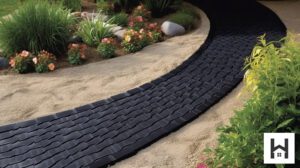
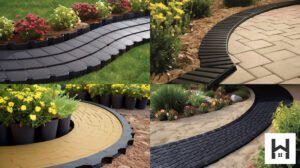
Flexible plastic edging is made from a pliable material that can be easily shaped and curved to fit the contours of your patio. This style is ideal for patios with curved or irregular borders, offering a seamless and clean appearance.
Rigid Plastic Edging
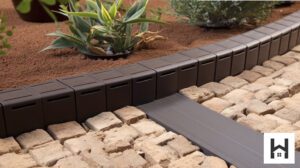
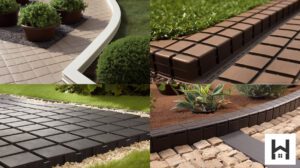
Rigid plastic edging consists of straight sections of plastic that can be connected to form a continuous border around your patio. This style offers a more structured and clean-lined appearance, making it suitable for contemporary or minimalist patio designs.
Decorative Plastic Edging
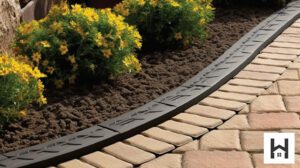
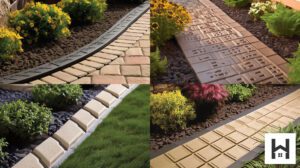
Decorative plastic edging features various patterns, textures, or faux finishes, such as brick, stone, or wood, providing a more visually interesting and appealing border for your patio. This style allows you to achieve the look of more expensive materials without the added cost or maintenance requirements.
Advantages of Plastic Edging
There are several benefits to choosing plastic as your patio paver edging material:
- Affordability: Plastic edging is generally more affordable than other materials like natural stone, metal, or wood, making it an excellent option for those on a tight budget.
- Ease of Installation: Plastic edging is lightweight and easy to work with, allowing for a quick and straightforward installation process that can be done by DIY enthusiasts or professionals alike.
- Low Maintenance: Plastic edging requires minimal upkeep, as it is resistant to moisture, rot, and insect damage, ensuring it maintains its appearance over time without the need for regular maintenance.
- Versatility: With a variety of styles, colors, and designs available, plastic edging can be tailored to suit your patio’s design and enhance its overall aesthetic appeal.
Disadvantages of Plastic Edging
While plastic edging offers several benefits, such as affordability, ease of installation, and low maintenance, it’s important to consider some potential drawbacks before deciding on this material for your patio borders. Understanding these disadvantages can help you make an informed decision about the best edging material for your outdoor space.
- Durability Concerns. One of the primary disadvantages of plastic edging is its lower durability compared to materials like metal, concrete, or natural stone. Plastic can become brittle and crack over time, especially when exposed to harsh weather conditions, sunlight, or fluctuating temperatures. Although it may be more affordable initially, you might end up replacing it more frequently than other more durable materials.
- Aesthetic Limitations. While plastic edging is available in a variety of styles and colors, it may not provide the same level of aesthetic appeal as natural materials like wood, stone, or even metal. Some homeowners may prefer the look and texture of these alternative materials over plastic, even when considering decorative or faux finishes.
- Environmental Impact. Plastic edging is made from non-renewable resources, and its production can contribute to pollution and environmental harm. Additionally, plastic is not biodegradable and may take hundreds of years to break down in a landfill. This makes it a less environmentally friendly option compared to materials like wood or even metal, which can be recycled or repurposed.
- Susceptibility to UV Damage. Plastic edging can become discolored or weakened due to prolonged exposure to sunlight and UV rays. Over time, this can lead to fading, cracking, or warping, negatively impacting the appearance and functionality of your patio edging. Some higher-quality plastic edging products may include UV inhibitors to help mitigate this issue, but it’s essential to be aware of the potential for UV damage.
Design Ideas for Paver Edging
Creating a visually appealing and functional patio space involves more than just selecting the right pavers. Choosing a suitable edging design can significantly enhance the overall aesthetic and structure of your patio. Here are some design ideas for paver edging that can elevate your outdoor space:
Traditional Edging
Traditional edging involves using a continuous, uniform material, such as brick, stone, or metal, to create a clean and structured border around your patio. This classic design works well with various patio styles and materials, providing a cohesive and visually appealing finish.
Mitered Corners
Mitered corners are created by cutting edging materials, such as bricks or natural stones, at a 45-degree angle to form a clean and precise corner. This technique gives your patio edging a polished and professional appearance, making it an excellent option for those seeking a refined and elegant look.
Curved Designs
Curved edging designs add a sense of movement and fluidity to your patio, making it appear more organic and visually interesting. Flexible edging materials, such as plastic, metal, or even some types of wood, can be easily shaped to create graceful curves and contours that complement your patio’s overall design.
Raised Edging
Raised edging involves building your patio border slightly higher than the paver surface, creating a distinct and visually striking separation between your patio and surrounding landscape. This design not only adds visual interest but also helps contain your patio materials, ensuring they remain in place over time.
Mixing Materials
Combining different edging materials can create a unique and eye-catching border for your patio. For instance, you might use natural stone for the primary edging and accent it with metal or wood to create a contrasting and visually appealing design. Mixing materials allows you to customize your patio’s appearance and showcase your personal style.
FAQs
How do I choose the right edging material for my patio pavers?
Consider factors such as your patio’s overall design, the climate in your area, and your budget when selecting an edging material. It’s essential to choose a material that complements your patio’s aesthetic and can withstand the elements.
Can I install patio paver edging myself, or should I hire a professional?
While some edging materials and techniques can be DIY-friendly, it’s generally recommended to consult with or hire a professional landscaper or hardscaping specialist. This ensures proper installation, which is crucial for maintaining the structural integrity and appearance of your patio.
How do I maintain my patio paver edging?
The maintenance requirements for your edging will depend on the material you choose. Generally, regularly inspecting the edging for signs of damage, cleaning debris and dirt, and applying sealants or protective coatings when necessary can help prolong the lifespan of your patio paver edging.
Conclusion
Patio paver edging plays a crucial role in the overall look and functionality of your outdoor space. With a wide variety of materials and styles to choose from, you can create a unique and inviting patio that reflects your personal taste and enhances your outdoor living experience. Explore the numerous patio paver edging ideas presented in this article and transform your outdoor oasis into a true masterpiece.


